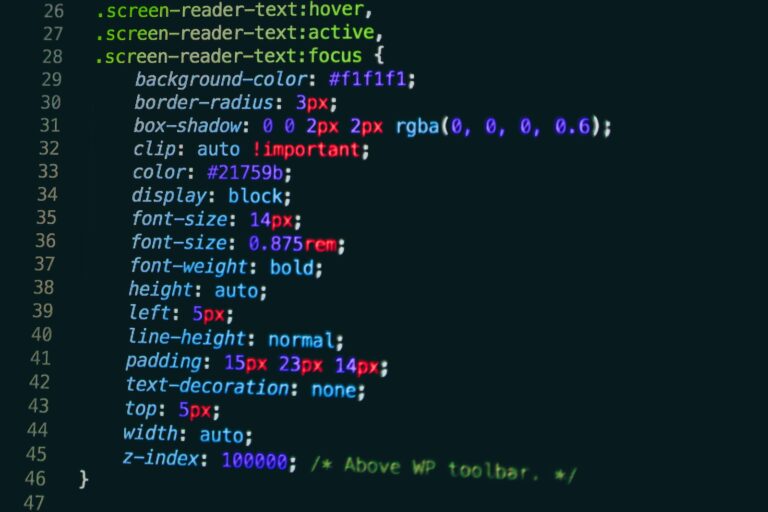Creating efficient and future-proof stylesheets for responsive web design requires a solid CSS architecture strategy. In this comprehensive guide, we will explore the key strategies and methodologies for creating an effective CSS architecture that will enhance the maintainability and scalability of your CSS codebase.
We will delve into popular methodologies such as BEM (Block-Element-Modifier), OOCSS (Object-Oriented CSS), and SMACSS (Scalable and Modular Architecture for CSS). These approaches will help you create maintainable stylesheets that are well-organized and optimized for responsive web design.
Key Takeaways:
- Effective CSS architecture is crucial for a successful web design project.
- BEM, OOCSS, and SMACSS are popular CSS architecture methodologies.
- Consistent naming conventions, file organization, and performance optimization are key aspects of CSS architecture.
- Responsive CSS architecture is essential for delivering fast and seamless user experiences across devices.
- Practical tips and case studies will be provided to illustrate effective CSS architecture implementation.
Understanding CSS Architecture and its Importance
As websites become more complex and dynamic, it’s important to have a strategy for organizing your CSS code. This is where CSS architecture comes into play. CSS architecture is the practice of organizing and structuring your CSS code in a way that promotes scalability, modularity, and maintainability. Effective CSS architecture can help you create stylesheets that are easy to maintain, optimize for performance, and accommodate responsive design.
CSS architecture provides several benefits, including:
- Code organization: CSS architecture helps you organize your code in a logical, modular way that makes it easy to find and update specific styles.
- Scalability: By breaking down your CSS into smaller, reusable modules, you can scale your codebase as your website grows without sacrificing maintainability.
- Performance optimization: Clean, well-organized CSS files can improve page load times and reduce server requests, resulting in a faster website.
Next, we’ll explore three popular CSS architecture methodologies: BEM, OOCSS, and SMACSS. Each of these approaches provides a unique set of guidelines and best practices for structuring your CSS code.
BEM (Block-Element-Modifier) Methodology
BEM is a popular CSS architecture methodology that emphasizes modularity and reusability. It is based on the principle of breaking down web interfaces into small, manageable components, or “blocks”. Each block consists of one or more “elements” that represent the parts of the block, and “modifiers” that define the variations of the block.
The BEM naming convention is structured as follows: .block__element–modifier. The double underscore “__” separates the element from the block, and the double dashes “–” separate the modifier from the block or element. BEM naming convention promotes clear and consistent naming, which makes it easier to understand the structure and dependencies of CSS classes, and helps avoid naming conflicts.
Let’s consider an example of a navigation menu:
| BEM class | Description |
|---|---|
| .nav | The main navigation block |
| .nav__item | The individual item(s) within the navigation block |
| .nav__item–active | The active item(s) within the navigation block |
Using BEM, we can create modular and maintainable stylesheets that are easy to scale and modify. By breaking down the interface into blocks, elements, and modifiers, we can organize our CSS code in a logical and structured way, and minimize code redundancy and specificity. With BEM, we can also create reusable components and improve the maintainability and consistency of our CSS codebase.
OOCSS (Object-Oriented CSS) Approach
The OOCSS approach is another popular CSS architecture methodology that emphasizes modular CSS code. The central idea is to separate the structure of an element from its visual appearance, or “skin”. By creating reusable classes that describe the structure and behavior of an element, you can create a more modular and scalable CSS codebase.
One of the key advantages of the OOCSS approach is its ability to enhance code reusability. By defining classes that describe the structure of an element, you can reuse them across multiple elements without having to redefine the same styles. This not only saves development time but also makes the codebase more maintainable in the long run.
Another benefit of the OOCSS approach is its focus on the separation of concerns. By defining classes that describe the structure of an element, and separate classes that describe its visual appearance, you can easily update the visual styles without impacting the overall structure of the element. This makes it easier to maintain and update the codebase over time.
OOCSS Principles
The OOCSS methodology is driven by the following principles:
- Separation of Structure and Skin: As mentioned before, the OOCSS approach focuses on separating the structure of an element from its skin. By creating separate classes for each, you can easily update the visual appearance of an element without impacting its structure.
- Reusability: The OOCSS approach emphasizes code reusability by creating classes that describe the structure and behavior of an element. This makes it easier to reuse the same classes across multiple elements.
- Maintainability: By separating the structure and skin of an element, the OOCSS approach makes it easier to maintain and update the codebase over time.
- Scalability: The OOCSS approach is designed to be scalable, making it ideal for large and complex codebases. By reusing classes and keeping the codebase modular, you can easily add or modify styles as needed without impacting the overall architecture.
Implementing OOCSS
To implement the OOCSS methodology, you should follow these steps:
- Create reusable classes: Begin by defining classes that describe the structure and behavior of an element. These classes should be reusable and easy to understand.
- Create separate classes for skin: Once you have defined the structure of an element, create separate classes for its visual appearance or “skin”. These classes should describe the visual styles of an element, such as its color, font, and size.
- Use classes together: To apply styles to an element, use both the structure and skin classes together. By combining these classes, you can easily update the visual appearance of an element without impacting its structure.
By following these steps, you can create a more modular, maintainable, and scalable CSS codebase using the OOCSS approach.
SMACSS (Scalable and Modular Architecture for CSS)
SMACSS is a popular CSS architecture approach that emphasizes modularity and scalability. It provides a comprehensive set of guidelines for structuring your CSS codebase, making it easier to maintain and update.
The core principles of SMACSS are based on the concept of five types of categories:
| Type | Description |
|---|---|
| Base | The base category contains styles for global elements such as headings, paragraphs, and links. These styles apply to all pages on the website. |
| Layout | The layout category contains styles for the overall layout of the website, such as the header, main content, and footer. These styles define the structure of the website and are independent of the content within. |
| Module | The module category contains styles for individual reusable components, such as a navigation menu or a comment form. These styles are designed to be self-contained and independent of the context in which they are used. |
| State | The state category contains styles that describe the current state of an element, such as a button that is currently active or disabled. These styles are often used in conjunction with JavaScript to create interactive elements. |
| Theme | The theme category contains styles for the overall visual style of the website, including typography, colors, and imagery. These styles are typically applied globally and can be easily modified to achieve a different look and feel. |
By organizing your CSS codebase into these categories, you can create a modular and maintainable structure that is easy to update and extend over time.
SMACSS also promotes the use of preprocessors, such as Sass or Less, to streamline the development process. By using features such as variables and mixins, you can create reusable code that is easy to maintain and update.
Overall, SMACSS is an effective approach to CSS architecture that emphasizes modularity, scalability, and maintainability. By following its principles, you can create a well-organized and optimized CSS codebase that is flexible enough to adapt to changing design requirements.
CSS Naming Conventions and Best Practices
CSS naming conventions and best practices are imperative for creating a scalable and maintainable CSS codebase. By following consistent naming conventions and best practices, you can enhance the readability, modularity, and maintainability of your code.
BEM Naming Convention
The BEM (Block-Element-Modifier) naming convention is a popular approach for naming CSS classes. BEM promotes a modular and reusable approach to styling by breaking down CSS classes into three parts: Block, Element, and Modifier.
| BEM Convention | Example |
|---|---|
| Block | .card |
| Element | .card__heading |
| Modifier | .card__heading–bold |
By adhering to the BEM naming convention, you can create a clear and straightforward hierarchy of CSS classes, making it easier to identify and modify specific styles.
Additional Best Practices
In addition to naming conventions, there are other best practices for CSS code organization:
- Use lowercase letters and hyphens to separate words in CSS class names.
- Avoid using IDs for styling as they have higher specificity and can cause conflicts.
- Use semantic class names that describe the content or function of the element.
- Keep the number of selectors in a rule as low as possible to minimize specificity and increase maintainability.
Remember, CSS naming conventions and best practices are not strict rules; they are guidelines that you can modify to suit your project’s specific needs.
Organizing CSS Files and Creating a Modular Structure
Effective organization of CSS files is key to maintaining a scalable and manageable codebase. Without proper organization, CSS files can become bloated, difficult to navigate and maintain. In this section, we will guide you through strategies for structuring your CSS files in a modular and organized manner.
Separation of Concerns
A key concept in organizing CSS files is the separation of concerns. This means separating the structure and layout of a web page from its visual style. By separating concerns, you can more easily maintain, update, and reuse your code.
One effective way to separate concerns is to use different CSS files for different sections of your website. For example, you might have one CSS file for the header, another for the footer, and another for the main content area.
File Organization Techniques
Another strategy for organizing CSS files is to use a consistent file naming scheme and folder structure. This makes it easier to locate and manage your CSS files, especially as your codebase grows in size and complexity.
Here’s an example folder structure for a typical website:
| Folder | Description |
|---|---|
| css | Holds all CSS files |
| css/base | Contains base styles shared between all pages |
| css/layout | Contains styles for layout components |
| css/modules | Contains styles for reusable components |
| css/pages | Contains styles specific to individual pages |
Using a file naming scheme that follows the same folder structure can make it easier to locate and update individual CSS files.
Using Preprocessors
Preprocessors like Sass and Less can also help you organize your CSS files by allowing you to break down your styles into reusable mixins and variables. This can make it easier to maintain your code, avoid repetition, and make changes more quickly.
For example, you might define a “primary color” variable in your preprocessor file, and then use that variable throughout your CSS files instead of hardcoding the color value.
Summary
Effective organization of your CSS files can make a significant difference in the maintainability and scalability of your code. By separating concerns, using consistent file naming and folder structures, and utilizing preprocessors, you can create a more modular and organized CSS codebase.
Performance Optimization Techniques for CSS
CSS performance optimization is critical for ensuring that your web pages load quickly and efficiently. Here are some key strategies for optimizing your CSS code:
Minification
Minification involves removing any unnecessary characters or spaces from your CSS code. This can significantly reduce the file size and improve page load times. There are a variety of tools available for minifying CSS, such as Minify and Clean-CSS.
Consolidation
Consolidating multiple CSS files into a single file can improve page load times by reducing HTTP requests. However, it’s important to be strategic about which styles are combined into the consolidated file, as it can still become too large and negatively impact performance.
Reducing Specificity
CSS specificity determines which styles are applied to a particular element. Overly specific styles can lead to bloated CSS code and slow performance. To reduce specificity, avoid chaining multiple classes and IDs together in selectors and instead use more general styles where appropriate.
CSS Preprocessors
CSS preprocessors like Sass and Less can greatly improve CSS organization and performance by allowing for the use of variables, mixins, and other advanced features. These tools can also simplify the process of minification and consolidation.
File Size and Prioritization
Finally, it’s important to consider the file size of your CSS code and how it is prioritized for loading. Large stylesheets should be loaded asynchronously, or after the rest of the page has loaded, to prevent delays in rendering. Additionally, critical styles that are necessary for above-the-fold content should be prioritized and loaded before other stylesheets.
Creating Responsive CSS Architecture
In today’s world of responsive web design, creating a CSS architecture that adapts to different screen sizes and devices is essential. Here are some effective strategies for designing a responsive CSS architecture:
Use Media Queries
Media queries are a powerful tool for adapting CSS styles to different screen sizes. By defining specific CSS rules for different device widths, you can ensure that your website looks great on any screen. Use a mobile-first approach when writing media queries, and optimize your styles for smaller screens before scaling up to larger ones.
Create Fluid Grids
Fluid grids are a flexible layout technique that adjusts to different screen sizes. By using percentage-based widths and flexible margins, you can create a layout that adapts to any device. Combine fluid grids with media queries to create a fully responsive CSS architecture.
Consider Responsive Images
Images are a crucial element of any web design, but they can also have a significant impact on page load times. Use responsive images to ensure that your images are optimized for different devices, and avoid using unnecessarily large image files that can slow down your site.
Think Mobile-First
When designing a responsive CSS architecture, it’s essential to prioritize mobile devices. By starting with a mobile-first approach, you can ensure that your site is optimized for smaller screens and slower connections. This approach can also help you minimize bloat and create a leaner, more efficient CSS codebase.
Implementing Scalable CSS Architecture in Real-World Projects
Creating a scalable CSS architecture requires more than just knowledge of principles and methodologies. It is equally important to implement these strategies effectively in real-world projects. Here are some practical tips to help you achieve a scalable and maintainable CSS codebase:
1. Plan and Define Your CSS Architecture
Before you start writing CSS code, take the time to plan and define your CSS architecture. This includes identifying the components, modules, and layouts that will be used across your website or application. By defining these in advance, you can ensure that your CSS code is consistent, reusable, and maintainable.
2. Use a Preprocessor
Using a preprocessor like Sass or Less can significantly improve the scalability and maintainability of your CSS codebase. Preprocessors allow you to write CSS code in a more organized and modular way by using variables, mixins, and functions. This can help you streamline your development process, reduce code duplication, and minimize errors.
3. Leverage Version Control
Version control systems like Git can be incredibly helpful for managing large-scale CSS projects. They allow you to track changes, collaborate with team members, and revert to previous versions if necessary. By using version control, you can ensure that your CSS codebase is always up-to-date, consistent, and organized.
4. Create Style Guides and Pattern Libraries
Style guides and pattern libraries can be invaluable for maintaining a consistent and scalable CSS codebase. By documenting your components, modules, and layouts in a style guide or pattern library, you can ensure that everyone on your team is using the same naming conventions, styles, and best practices. This can help you streamline your development process, reduce errors, and improve scalability.
5. Test Your CSS Codebase
Testing your CSS codebase is crucial for ensuring that it is scalable and maintainable. You should test your CSS code regularly across different devices, browsers, and screen sizes to ensure that it is responsive and performs well. You should also test your CSS code for maintainability, consistency, and performance optimization.
By following these tips and strategies, you can implement a scalable and maintainable CSS architecture in your real-world projects. Remember to plan and define your CSS architecture, use a preprocessor, leverage version control, create style guides and pattern libraries, and test your CSS code regularly to ensure that it is scalable and future-proof.
Conclusion
Creating an effective CSS architecture is crucial for a successful web design project. By adopting popular methodologies such as BEM, OOCSS, and SMACSS, you can ensure that your stylesheets are well-organized and optimized for scalable and modular styling. Consistent naming conventions and best practices play an important role in CSS code organization, while effective file structure and performance optimization techniques can significantly enhance website speed and responsiveness.
Designing for responsiveness is paramount in today’s mobile-first world, and CSS architecture strategies can help you achieve a seamless user experience across devices. By implementing scalable CSS architecture in real-world projects, you can overcome common challenges and maintain a codebase that is efficient and future-proof.
Upgrade Your CSS Architecture Skills
It is essential to continually upgrade your CSS architecture skills to keep up with the ever-evolving web design landscape. By following the best practices and guidelines provided in this guide, you can enhance the maintainability, scalability, and performance optimization of your CSS codebase. These strategies and methodologies will help you create efficient and effective stylesheets for responsive web design.
Upgrade your CSS architecture skills today and take your web design projects to the next level!







